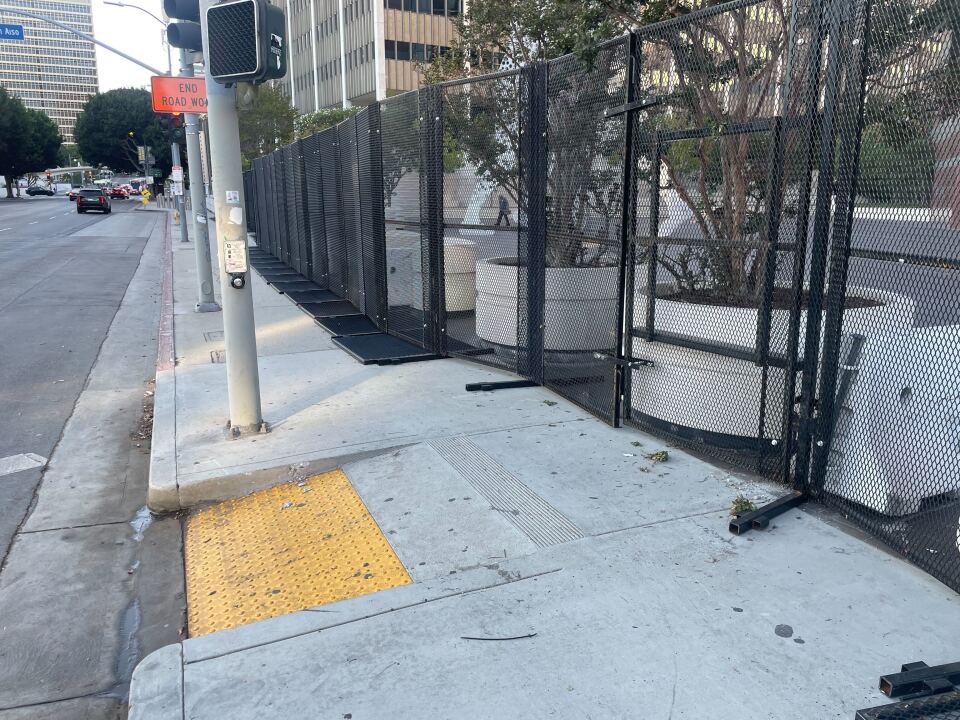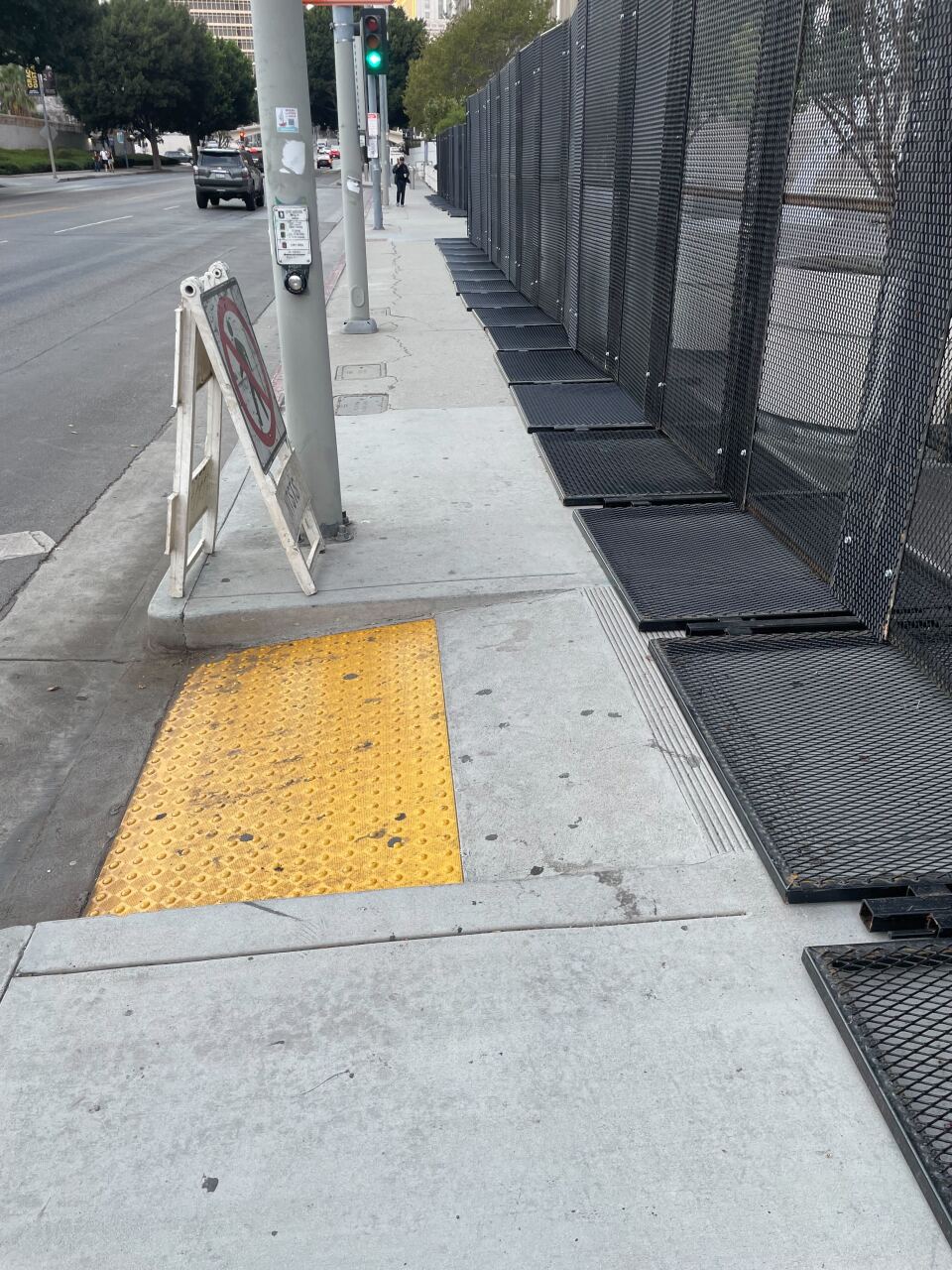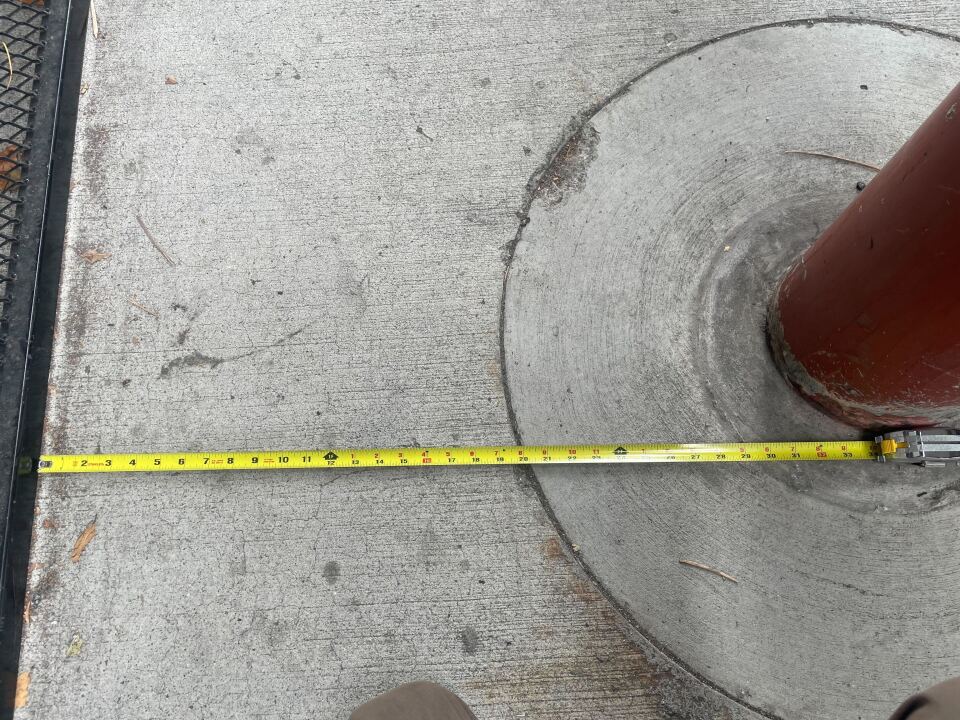Truth matters. Community matters. Your support makes both possible. LAist is one of the few places where news remains independent and free from political and corporate influence. Stand up for truth and for LAist. Make your year-end tax-deductible gift now.
Fencing outside federal buildings in downtown LA creates accessibility concerns

When 8-foot-tall fences went up outside federal buildings in downtown Los Angeles last month during a relatively calm moment in the city’s summer of protest, they quickly drew attention on social media.
One Reddit commenter wrote, “why would a Federal building in Los Angeles [start] turning into a fortress?”
Besides the optics of putting up the fencing, it also created accessibility concerns. The fencing had blocked parts of the sidewalk and a pedestrian on-ramp on Temple Street, risking potential issues of compliance with federal accessibility laws, according to LAist’s measurements and observations.
But as of 6 p.m. on Sept. 4, within three hours of LAist’s initial publication, the fences had been adjusted to create a level space at the top of the curb ramp on Temple, allowing more space for people in wheelchairs to get by. Other than that, the fencing appears not to have been moved significantly.

The Little Tokyo federal building complex, especially the Metropolitan Detention Center on Alameda Street, has been an epicenter of anti-immigration enforcement protests since June. It’s also a block up the street from the Japanese American National Museum, where federal agents staked out Gov. Gavin Newsom’s news conference on redistricting last month.
StreetsLA, the city agency that investigates issues with the public right-of-way, said that it is looking into the matter. The city disability department criticized the initial placement of the barricades.
LAist also asked federal officials to identify who's responsible for putting up the fencing, but has not heard back.
The blocked pedestrian ramp
Before Sept. 4, the fencing on East Temple Street completely blocked the level portion of the sidewalk, obstructing the pathway for people using wheeled transportation.
This portion of the sidewalk is on the same block as many federal offices, including a bankruptcy court and a Department of Veterans Affairs clinic. The Rehabilitation Act of 1973 prohibits any federal department from “denying individuals with disabilities an equal opportunity to receive program benefits and services.”

The law specifically prohibits federal agencies from denying access to programs, services or opportunities “as a result of physical barriers.”
The sidewalk alongside the federal building complex is the only open sidewalk on the portion of Temple by the VA clinic — the sidewalk across the street is currently closed for construction.
Autumn Elliott, a longtime disability rights attorney and expert on the Americans with Disabilities Act, said obstructing sidewalks could easily raise questions of compliance with federal regulations.
“If you've got a situation where, for example, somebody who uses a wheelchair wouldn't be able to get over it, or would risk injury trying to get over it, or would have to be a Paralympian in order to do it, then that's a problem,” Elliott said.
Zeenat Hassan, a lawyer with the nonprofit Disability Rights California, also said federal law is clear that sidewalks should be free of obstructions.
“ It's not really clear to me how a person in a wheelchair is supposed to safely move from the crosswalk onto the sidewalk and continue their pathway,” Hassan said.
Elliott and Hassan, who didn’t comment specifically on the fencing downtown, said this applies even if the obstructions aren’t permanent.
“ The whole point of the ADA is that we increase access in the built environment over time,” Hassan said. “There's no carveout for things just because they're not permanent structures.”
Elliott pointed to a case, Cohen v. City of Culver City, where the federal Ninth Circuit of Appeals ruled that blocking curb ramps may violate the ADA even when other nearby ramps are available. In the case of the obstructed sidewalk on Temple, the closest pedestrian curb ramp is located hundreds of feet away at the end of the block.

What the city says
StreetsLA is the city department responsible for investigating issues of sidewalk compliance. LAist has reached out repeatedly to the department for a response. A department spokesperson told LAist, “We are looking into it.”
Before the fencing was moved, officials from the city’s disability department criticized the placement of the fencing when shown pictures taken by LAist.
“While the City’s Department on Disability does not oversee enforcement of public right-of-way issues, we strongly encourage all levels of government to meet their obligations to maintain accessible public spaces,” Stephen David Simon, executive director of Los Angeles’s Department on Disability, wrote in a statement to LAist.
“Hopefully the barriers are adjusted to ideally give 48” of accessible pathway," Simon added.
California’s building code requires a minimum sidewalk width of 48 inches, which is stricter than federal regulations. LAist has reached out to the Department on Disability for a follow-up comment.
Requests for comment sent to Mayor Karen Bass and councilmember Ysabel Jurado, who represents Little Tokyo, were not returned by the time of publication.
Other potential issues
The fencing also juts out onto sidewalks on North Alameda Street.
Last week, there were multiple points on Alameda with less than 32 inches of passable sidewalk, the bare minimum required by federal accessibility standards. (Sidewalks must be a minimum of 36 inches wide under federal standards, but they allow for that width to narrow to 32 inches in some limited sections.)

But as of Aug. 27, the fencing had been scooched over, and the sidewalk along Alameda now has 32 inches of space at all points — with about an inch or so to spare in some cases.

But Hassan said that could still pose accessibility issues.
“ The 32-inch minimum is really designed with a standard wheelchair in mind, but there's a lot of people who have wheelchairs that are bigger than a standard wheelchair,” Hassan said. “ To the extent you can make something more accessible beyond the minimum, you should, because then you are maximizing access for a greater number of people.”
LAist stopped by the fencing outside the federal building complex at several points in the last two weeks. Cyclists and pedestrians with roller bags ran into visible difficulty circumventing the barricades, though they did eventually pass through. Meanwhile, some pedestrians avoided the crowded, narrow sidewalks entirely by walking in the road.
The backstory
According to a video posted by L.A. Taco, the fencing started going up during the day on Aug. 21. LAist first observed the fencing on Aug. 22.
It’s not clear which government agency is responsible for erecting the fences. LAist has reached out to the federal Bureau of Prisons, which manages the Metropolitan Detention Center, for comment.
This isn’t the first time in recent years fencing outside federal buildings has encroached on land in the public right-of-way — nor is it the first time it’s happened under a Trump presidency. During Black Lives Matter protests in 2020, federal officials put up fences outside a federal courthouse in Portland, Oregon, according to Oregon Public Broadcasting. Those fences blocked a bike lane, which city officials said created “a hazard to the public.”
The city of Portland issued the federal government the maximum penalty of $11 million, according to the Associated Press. That fine was waived in April 2021 after the fencing came down under a new administration.
How to report a sidewalk issue
- If you run into an obstructed sidewalk, you can report it to the city online or by calling 311.
- For sidewalks that need repairs, the city has a rebate program for property owners to get reimbursed for hiring their own contractors. Be advised that the rebate program is currently experiencing delays due to funding issues, according to the city.
Updated September 4, 2025 at 8:32 PM PDT
UPDATE: As of 6 p.m. Thursday, Sep. 4, the fencing has been moved and no longer blocks the pedestrian curb ramp on Temple. LAist will bring you updates as we find out more.













